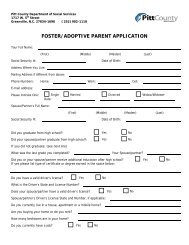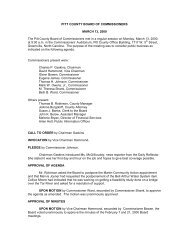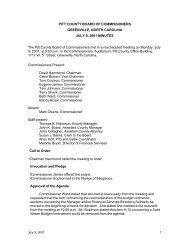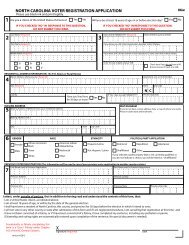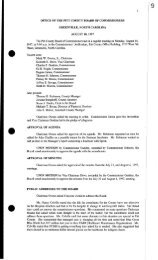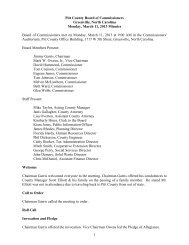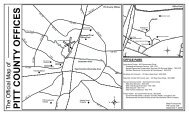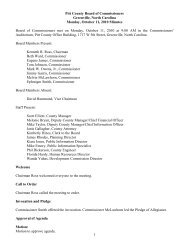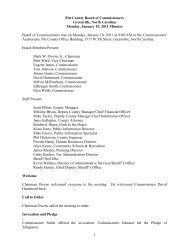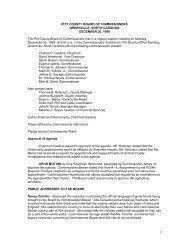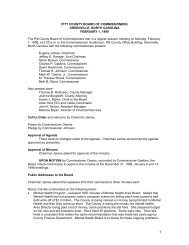2030 Comprehensive Land Use Plan - Pitt County Government
2030 Comprehensive Land Use Plan - Pitt County Government
2030 Comprehensive Land Use Plan - Pitt County Government
- No tags were found...
You also want an ePaper? Increase the reach of your titles
YUMPU automatically turns print PDFs into web optimized ePapers that Google loves.
Stormwater Regulations<strong>Pitt</strong> <strong>County</strong>, along with a number of other local governments in North Carolina, was requiredby the State to implement a stormwater management program. The goal of this program is toimprove water quality in streams, creeks and rivers by reducing the amount of pollutants instormwater runoff.Neuse River and Tar-Pamlico River Basin RulesThe Neuse River Basin begins in the north-central Piedmont Region of North Carolina.Stretching 248 miles from the Falls Lake Reservoir Dam in the Piedmont flowing throughRaleigh, Goldsboro and Kinston to its mouth at Pamlico Sound near New Bern, the NeuseRiver is the longest river in North Carolina. At its mouth, it is the widest river in America —6 miles across.The Tar River collects stormwater flow from approximately 2,300 miles of freshwaterstreams before entering the estuarine Pamlico River at the City of Washington. The Tar-Pamlico River Basin begins in Person <strong>County</strong> in the Piedmont Region of North Carolina andextends approximately 180 miles through the Coastal Plain. The 5,400 square mile basinencompasses portions of eighteen counties, including the cities of Rocky Mount, Tarboroand Greenville as well as agricultural and forest land.<strong>Pitt</strong> <strong>County</strong> is one of a number of local governments within the Tar-Pamlico River Basinthat are subject to the Tar-Pamlico Riparian Buffer and Stormwater Rules. The six cities ofGreenville, Henderson, Oxford, Rocky Mount, Tarboro and Washington and five counties –Beaufort, Edgecombe, Franklin, Nash, and <strong>Pitt</strong> – are affected by the rules.The goal of the State water quality rules is to maintain phosphorus loading levels at preexisting1991 levels, to reduce nitrogen loading 30% below 1991 levels and to reduce thevelocity and to control the volume of storm water runoff within the basins. River basinrules are intended to be performance-based rather than prescriptive meaning there is achoice of best management practice options from which land users developers and localgovernments can choose.The North Carolina Division of Water Quality has developed similar rules for improvingwater quality within the Neuse River Basin. Although approximately 40% of <strong>Pitt</strong> <strong>County</strong> iswithin the Neuse River Basin, <strong>Pitt</strong> <strong>County</strong> was not subject to the Neuse River Basin Rules.However, the <strong>Pitt</strong> <strong>County</strong> Stormwater Advisory Committee recommended that thestormwater rules be enforced countywide, with the exception of phosphorus loadingrequirements in the Neuse River Basin.Despite the rural character of the basin, in the mid-1970’s the Pamlico River estuary beganto see increasing frequencies of harmful algal blooms, fish kills, and other nutrient-relatedproblems.By the mid-1980’s, the state began to consider actions to control nutrient inputs to theestuary. Those actions have included the following:Phase IIn 1989, the North Carolina Environmental Management Commission (EMC)designated the entire basin as “Nutrient Sensitive Waters”. The first phase of<strong>2030</strong> <strong>Comprehensive</strong> <strong>Land</strong> <strong>Use</strong> <strong>Plan</strong> Appendix A: Inventory and Analysis<strong>Pitt</strong> <strong>County</strong>, North Carolina A-83



